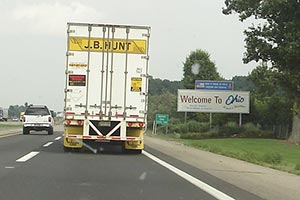Hearing-Impaired Can Obtain Ohio Commercial Driver License

The deaf and hearing-impaired have a new career option, as a truck driver.
The Ohio Bureau of Motor Vehicles, Office of Criminal Justice Services and Opportunities for Ohioans with Disabilities have joined to develop procedures that allow the deaf and hearing-impaired to qualify for a waiver that allows them to train and test for a commercial driver license.
Before now, the deaf and hearing-impaired could not do so.
“With some minimal adjustments and communication adjustments, you could remove barriers and those individuals could do the job,” said Kevin Holtsberry, spokesman for Opportunities for Ohioans with Disabilities.
The process to obtain a waiver was instituted by the Federal Motor Carrier Safety Administration. Ohio is one of the first states to implement testing.
RELATED: Group Seeks to Exempt Deaf Drivers From Federal Hearing Requirements
The Bureau of Motor Vehicles has come up with testing procedures for the deaf and hearing-impaired to obtain a commercial license. They allow, for example, an interpreter to be available for instructions but not during the test.
That information has been shared with those who are hearing-impaired along with driver-training schools.
At least 10 people have started the process of obtaining a waiver, or getting training or testing. Two have received their licenses and started jobs as commercial drivers.
Allowing the deaf and hearing-impaired to get a commercial license is a result of the Governor’s Workforce Integration Task Force. The task force was charged with gathering and analyzing data to make recommendations regarding barriers to employment and income parity for those who are deaf and blind.
The change is welcome news for the trucking industry, which has a shortage of drivers.
Industry estimates peg the shortage at 50,000 drivers nationwide, a number that is expected to grow to 200,000 over the next 10 years, Ohio Trucking Association President Tom Balzer said.
“These drivers can operate commercial motor vehicles as safely as anyone else as long as they follow safety protocols,” he said.
Drivers used to depend on their hearing to tell when it was time to shift gears or if there was a problem with the truck’s motor. Now computer and dashboard systems can do that. Some trucks are even equipped with automatic transmissions.
Companies can communicate with drivers through satellite systems on the trucks using a kind of text messaging during times when it is safe to do so, he said.
“There’s nothing that prohibits them from maintaining employment and actively engaging in commercial motor vehicle usage,” he said.

